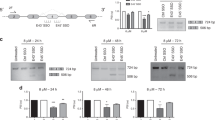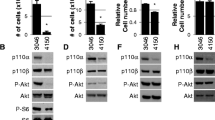Abstract
Antisense oligonucleotides (oligos) have been evaluated in both in vivo and in vitro prostate cancer models. Although most contain a single mRNA binding site, our laboratory has also evaluated bispecific types directed toward two proteins. This study evaluates the inhibition of in vitro propagating LNCaP cells employing mono- and bispecific oligos directed against bcl-2 [the second binding site was directed against the epidermal growth factor receptor (EGFR)]. Employing RT–PCR, the expression of two apoptosis regulating proteins, bcl-2 and non-targeted bax, was then evaluated. LNCaP prostate tumor cells were initially incubated for 24 h in the presence of oligos (6.25 μM) directed against bcl-2 and compared to lipofectin containing controls. Comparable and significant growth inhibition was produced by both mono- and bispecific forms. Employing RT–PCR to determine the expression of bcl-2, we found that the greatest amount of mRNA suppression approached 100% for each oligo type: monospecific MR4 (directed only against bcl-2), 100%; and bispecifics MR24 and MR42, 86 and 100%, respectively. We conclude, based upon both inhibition of in vitro growth and bcl-2 expression, that bispecific antisense oligos directed against EGFR and bcl-2 mRNAs are at least as effective as a monospecific directed solely toward bcl-2. In an effort to determine a compensatory response by cells evading apoptosis in the presence of bcl-2 suppression, the levels of mRNA encoding the non-targeted apoptosis activating protein bax were evaluated. Non-targeted protein suppression by these bispecifics has previously been demonstrated against prostate-specific membrane antigen (PSMA). However, in contrast to effects against bcl-2 and PSMA, no significant alteration in bax expression was produced by either oligo type. In LNCaP cells, bcl-2 suppression does not influence bax expression and, at least for this protein, there is no compensatory change in bax expression regulating apoptosis at this level. Identifying changes in the expression of proteins which regulate apoptosis is important if gene therapy targets bcl-2.




Similar content being viewed by others
References
Walder RY, Walder JA. Role of RNase H in hybrid-arrested translation by antisense oligonucleotides. Proc Natl Acad Sci USA. 1988;85:5011–5.
Felsenfeld G, Miles HT. Formation of a three-stranded polynucleotide molecule. J Am Chem Soc. 1957;79:2023–4.
Durland RH, Kessler DJ, Hogan M. Antiparallel triplex formation at physiological pH. In: Wickstrom E, editor. Prospects for antisense nucleic acid therapy of cancer and AIDS. New York: Wiley-Liss; 1991. p. 219–26.
Rubenstein M, Tsui P, Guinan P. Construction of a bispecific antisense oligonucleotide containing multiple binding sites for the treatment of hormone insensitive prostate tumors. Med Hypotheses. 2005;65:905–7.
Rubenstein M, Tsui P, Guinan P. Bispecific antisense oligonucleotides with multiple binding sites for the treatment of prostate tumors and their applicability to combination therapy. Methods Find Clin Pharmacol. 2006;28:515–8.
Rubenstein M, Tsui P, Guinan P. Combination chemotherapy employing bispecific antisense oligonucleotides having binding sites directed against an autocrine regulated growth pathway and bcl-2 for the treatment of prostate cancer. Med Oncol. 2007;24:372–8.
Rubenstein M, Tsui P, Guinan P. Multigene targeting of signal transduction pathways for the treatment of breast and prostate tumors. Comparison between combination therapies employing bispecific oligonucleotides with either Rapamycin or Paclitaxel. Med Oncol. 2009;26:124–30.
Rubenstein M, Tsui P, Guinan P. Bispecific antisense oligonucleotides having binding sites directed against an autocrine regulated growth pathway and bcl-2 for the treatment of prostate tumors. Med Oncol. 2007;24:189–96.
Rubenstein M, Tsui P, Guinan P. Treatment of MCF-7 breast cancer cells employing mono- and bispecific antisense oligonucleotides having binding specificity towards proteins associated with autocrine regulated growth and bcl-2. Med Oncol. 2008;25:182–6.
Chen W, Yan C, Pu J, Hou J, Wen D, Guo Z. Regulation of EGF-receptor expression by TGFalpha in human prostate androgen-unresponsive cancer cells. Zhonghua Nan Ke Xue. 2006;10:595–7.
Seth D, Shaw K, Jazayeri J, Leedman PJ. Complex post-transcriptional regulation of EGF-receptor expression by EGF and TGF-α in human prostate cancer cells. Brit J Cancer. 1999;80:657–69.
Rubenstein M, Mirochnik Y, Bremer E, George D, Freilich L, Guinan P. Inhibitory effect of antisense oligonucleotides targeting epidermal growth factor receptor may not be related to changes in mRNA levels in human prostate carcinoma cells. Proceedings AACR. 2002;43:590a.
Yamanaka K, Miyake H, Zangemeister-wittke U, Jansen B, Gleave M. Novel bispecific antisense oligonucleotides inhibiting both Bcl-2 and Bcl-xL expression induce apoptosis and enhance chemosensitivity in human androgen-independent prostate cancer cells. Proceedings AACR. 2004; 45:Abstract #2930.
Takahara K, Muramaki M, Li D, Cox ME, Gleave ME. Insulin-like growth factor-binding protein-5 (IGFBP5) supports prostate cancer cell proliferation. J Urol. 2009;181:184a.
Golbano JM, Lόppez-Aparicio P, Recio MN, Pérez-Albarsanz MA. Finasteride induces apoptosis via Bcl-2, Bcl-xL, Bax and caspase-3 proteins in LNCaP human prostate cancer cell line. Int J Oncol. 2008;32:919–24.
Szostak MJ, Kaur P, Amin P, Jacobs SC, Kyprianou N. Apoptosis and bcl-2 expression in prostate cancer: significance in clinical outcome after brachytherapy. J Urol. 2001;165:2126–30.
Chang H-K, Mal-Soon S, Hye-Young Y, Jin-Wood L, Young-Sick K, Myoung-Hwa L, Jullia K, Khae-Hawn K, Chang-Ju K. Amygdalin induces apoptosis through regulation of bax and bcl-2 expressions in human DU145 and LNCaP prostate cancer cells. Biol Pharm Bull. 2006;29:1597–602.
Salakou S, Kardamakis D, Tsamandas AC, Zolota V, Apostolakis E, Tzelepi V, Papathanasopoul P, Bonikos DS, Papapetropoulos T, Petsas T, Dougenis D. Increased bax.bcl-2 ratio up-regulates caspase-3 and increases apoptosis in the thymus of patients with myasthenia gravis. In Vivo. 2007;21:123–32.
Perlman H, Zhang X, Chen MW, Walsh K, Buttyan R. An elevated bax/bcl-2 ratio corresponds with the onset of prostate epithelial cell apoptosis. Cell Death Differ. 1999;6:48–54.
Rubenstein M, Hollowell CMP, Guinan P. Increased prostate specific membrane antigen expression in LNCaP cells following treatment with bispecific antisense oligonucleotides directed against bcl-2 and EGFR. Med Oncol. (in press).
Basham TY, Nickoloff BJ, Merigan TC, Morhenn VB. Recombinant gamma interferon induced HLA-DR expression on cultered human keratinocytes. J Invest Derm. 1984;83:88–90.
Msujimoto M, Yip YK, Vilcek J. Interferon-gamma enhances expression of cellular receptors for tumor necrosis factor. J Immunol. 1986;136:2441–4.
Virus Weekly: June 1, 2004: http://www.highbeam.com/doc/1G1-117341301.html.
Huang H, Cheville JC, Pan Y, Roche PC, Schmidt LJ, Tindall DJ. PTEN induces chemosensitivity in PTEN-mutated prostate cancer cells by suppression of bcl-2 expression. J Biol Chem. 2001;276:38830–388306.
Rubenstein M, Mirochnik Y, Chow P, Guinan P. Antisense oligonucleotide intralesional therapy of human PC-3 prostate tumors carried in athymic nude mice. J Surg Oncol. 1996;62:194–200.
Wullner U, Neef I, Eller A, Kleines M, Tur MK, Barth S. Cell-specific induction of apoptosis by rationally designed bivalent aptamer-siRNA transcripts silencing eukaryotic elongation factor 2. Curr Cancer Drug Targets. 2008;8:554–65.
Yip KW, Mocanu JD, Au PY, Sleep GT, Busson D, Yeh P, Gilbert WC, O’Sullivan R, Gullane B, Bastianutto C, Liu FF. Combination bcl-2 antisense and radiation therapy for nasopharyngeal cancer. Clin Cancer Res. 2005;11:8131–44.
Mu Z, Hachem P, Pollack A. Antisense bcl-2 sensitizes prostate cancer cells to radiation. Prostate. 2005;65:331–40.
Lida A, Yamaguchi A, Hirose K. Telomerase activity in colorectal cancer and its relationship to bcl-2 expression. J Surg Oncol. 2000;73:219–23.
Rubenstein M, Anderson KM, Tsui P, Guinan P. Synthesis of branched antisense oligonucleotides having multiple specificities. Treatment of hormone insensitive prostate cancer. Med Hypoth. 2006;67:1375–80.
Acknowledgments
The Cellular Biology laboratory at the Hektoen Institute is supported, in part, by the Blum Kovler Foundation, the Cancer Federation, Safeway/Dominicks Campaign for Breast Cancer Awareness, Lawn Manor Beth Jacob Hebrew Congregation, the Max Goldenberg Foundation, the Sternfeld Family Foundation and the Herbert C. Wenske Foundation.
Author information
Authors and Affiliations
Corresponding author
Rights and permissions
About this article
Cite this article
Rubenstein, M., Hollowell, C.M.P. & Guinan, P. Bax expression remains unchanged following antisense treatment directed against BCL-2. Med Oncol 28, 852–858 (2011). https://doi.org/10.1007/s12032-010-9543-y
Received:
Accepted:
Published:
Issue Date:
DOI: https://doi.org/10.1007/s12032-010-9543-y




